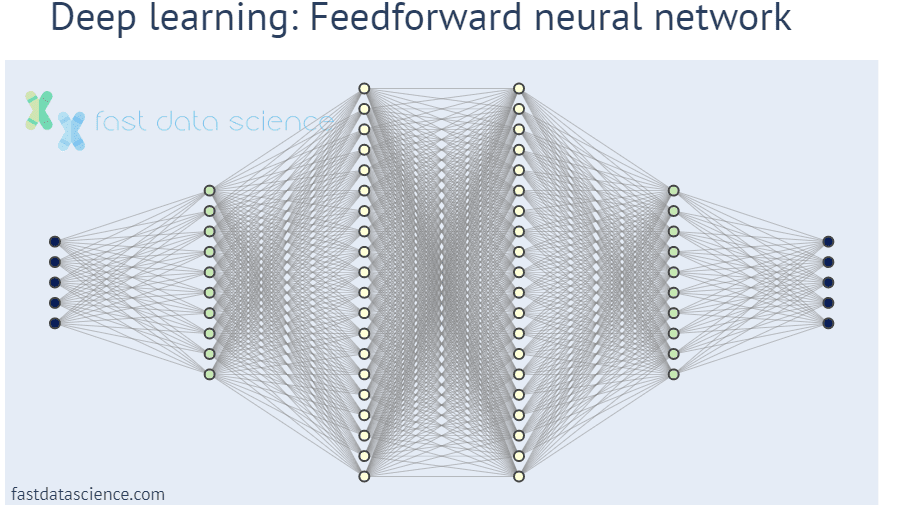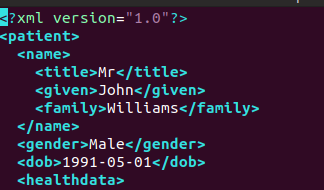At Fast Data Science, we offer deep learning consulting services for you to extract value from your organisation’s unstructured data.
Deep learning is a kind of machine learning that uses a layered structure to analyse data. Incoming data, such as an image, or a document, is passed through multiple layers, where each layer takes the output of the previous layer as input.

Representation of a deep feedforward neural network. Neural networks are the basis of deep learning models.
Deep learning is inspired by the way that neurons in humans and animals connect with one another and process signals. For this reason, deep learning models of this type are called artificial neural networks, or simply neural networks. We should stress that artificial neural networks are only loosely based on biological systems and there are many important differences.
Companies such as Google have invested in large projects training deep learning models to make predictions around hospitalised patients, predict patient lengths of stay and treatment outcomes, and supporting clinicians in decision making. In 2018, Google published a blog post on how they are using deep learning and natural language processing to analyse electronic health records.
At Fast Data Science we have more than ten years’ worth of experience providing machine learning consulting for problems in a variety of industries, including healthcare, insurance and legal. If you have a challenging problem in this field, feel free to contact us.

An example of an electronic health record (EMR). EMRs often contain large unstructured text fields, which are difficult to process with traditional analytics tools, but which can be easily handled with deep learning NLP models.
Natural language processing is one of the last great frontiers of artificial intelligence. Understanding complex utterances is a challenge but also a crucial task in AI. Today, NLP can be found everywhere because it is most natural for humans to communicate in language. Traditionally, rule based approaches were the norm for natural language processing. A company could hire a knowledge engineer to define a set of rules and vocabulary and build a chatbot manually. Thanks to modern advances in computing power and algorithms, deep learning is taking over these tasks.
Fast Data Science - London
Deep learning in NLP underlies web search interfaces, advertisements, email spam detection, customer service interactions, language translation, job recommendations, and many more areas.
At Fast Data Science we are experienced in training, developing, and deploying sophisticated natural language processing in a range of industries. We have built text classifiers for job recommendations, for clinical trial cost prediction, and for analysing manufacturing error reports. We can work with on-premise or cloud NLP and will provide a fast turnaround and professional service without jargon.
If you have a large set of documents, of the order of a million examples, and are struggling to extract patterns and value from them, please get in contact with us straightaway. This kind of dataset is often an untapped goldmine, and by involving Fast Data Science you can remain one step ahead of your competitors.
Recently, deep learning has begun to impact the pharmaceutical industry. The process of developing a new drug takes on average 12 years and is an extremely high-risk endeavour. Drug development starts with candidate compound identification, where thousands of molecules are examined for their properties and potential interactions in the human body. Deep learning has been deployed to revolutionise and accelerate this process, allowing molecules to be examined by algorithm instead of in vitro. Once the drug makes it through to pre-clinical and clinical trials, deep learning can help process the large amounts of unstructured biological and text data.
At Fast Data Science we have worked on a number of deep learning consulting projects in pharmaceuticals, from analysing manufacturing defects and identifying researchers and molecules from medical literature, to predicting complexity and cost of clinical trials from text documents.
Imagine you own a dating website and you have profile texts from all your users. You would like to identify the age and interests of your users from their profile texts so you can make recommendations.
Until recently if you wanted to do simple tasks such as identify the age, gender or demographic type of a user from this text, or recommend one profile to another, you would have had to hire somebody to spend months painstakingly engineering a set of rules to parse the text. Of course this doesn’t scale and you end up with a mess of rules that nobody understands and which are hard to maintain.
Unfortunately what I have described is the reality in many companies that have encountered this kind of problem, simply because no alternative was known at the time.
Today, an artificial neural network can be trained to learn from users’ actions and even predict the probability that a particular user will like, or contact, another user. This allows a highly subjective domain to be handled with quantitative methods.
At Fast Data Science, we have built this kind of recommender system, using deep learning and learning from user actions, in a number of industries. Please get in contact if you have a large dataset and need some deep learning consulting in order to begin to recommend items to users based on text features.
Deep learning allows us to produce computer programs that can analyse complex data such as text, images, sound or video with relatively little human instruction. This has many exciting applications in business and in most industries, companies have not yet started to tap the potential of deep learning.
In recent years huge advances have been made in deep learning. A major breakthrough was the PhD student Alex Krizhevsky’s convolutional neural network AlexNet, which set a new standard for image recognition. You can read more about convolutional neural networks in course CS231n, provided online by Stanford University. State of the art deep learning technologies today include generative adversarial networks, and transformers.
What we can do for you